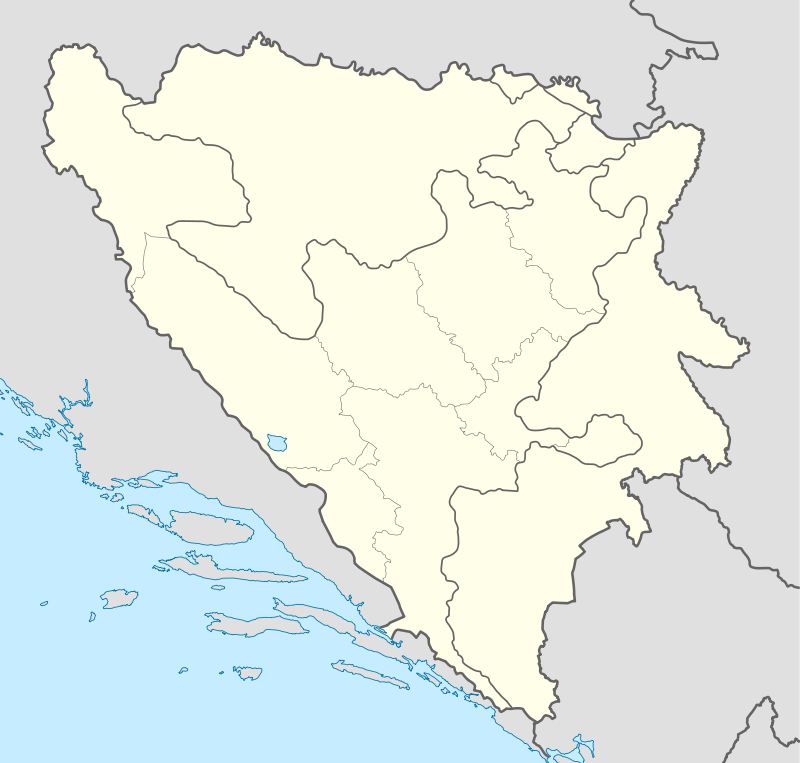Zavidovići
| Zavidovići Завидовићи | |
|---|---|
| Municipality | |
|
Alija Izetbegović street | |
 Location of Zavidovići municipality (općina) within Bosnia and Herzegovina. | |
 Zavidovići Location of Zavidovići | |
| Coordinates: 44°27′N 18°09′E / 44.450°N 18.150°E | |
| Country | Bosnia and Herzegovina |
| Entity | The Federation |
| Canton | Zenica-Doboj |
| Government | |
| • Municipality president | Suad Omerašević (SDA) |
| Area | |
| • Total | 590.3 km2 (227.9 sq mi) |
| Population (2013 census) | |
| • Total | 40,272 |
| • Density | 68/km2 (180/sq mi) |
| Time zone | CET (UTC+1) |
| • Summer (DST) | CEST (UTC) |
| Area code(s) | +387 32 |
| Website | http://www.zavidovici.ba |

Zavidovići is a town and municipality in central Bosnia and Herzegovina, located between Doboj and Zenica on the confluence of rivers Bosna, Krivaja and Gostović. It sits in a valley surrounded by many mountains of which the largest is Klek. It is administratively part of the Zenica-Doboj Canton of the Federation of Bosnia and Herzegovina.
History
Zavidovići was developed by the Austrians during the 19th century Austro-Hungarian reign in Bosnia, mostly because of the "wood industry". After World War II, Krivaja, the company that was founded in 1884 and named after the Krivaja river, expanded. The company focused on furniture manufacturing, which it began to export to the United States under the name "Krivaja Beechbrook". Due to the Bosnian war in the 1990s, the former giant and the town are left with almost nothing.
Although once a diverse town, many of the former Serb and Croat residents left their homes during the Bosnian war. Few have returned to their properties, and those who do often suffer discrimination. Now, it is a mostly Bosniak town, with few non-Bosniaks remaining.
Zavidovići's nickname is "Wood Town". Zavidovići is located in the basin of three rivers: Bosna, Krivaja and Gostović.
Demographics
The town of Zavidovići itself had 12,947 residents in 1991.
| Ethnic Composition | |||||
| Bosniaks | Serbs | Croats | Yugoslavs | Others | Total |
|---|---|---|---|---|---|
| 1961 | |||||
| 17,758 48.99% | 11,119 30.67% | 6,528 18.01% | 649 1.79% | 196 0.54% | 36,250 |
| 1971 | |||||
| 24,803 56,34% | 11.031 25,06% | 7,457 16,94% | 353 0.80% | 374 0.86% | 44,018 |
| 1981 | |||||
| 29,289 56.48% | 11,202 21.60% | 7,451 14.37% | 3,234 6.24% | 685 1.32% | 51,861 |
| 1991[1] | |||||
| 34,198 59.83% | 11,640 20.36% | 7,576 13.25% | 2,726 4.77% | 1,024 1.79% | 57,164 |
Settlements
- Borovnica
- Gornji Junuzovići
- Gostovići
- Hajderovići
- Hrge
- Kamenica
- Karačić
- Krivaja
- Krčevine
- Kućice
- Lijevča
- Mahoje
- Majdan
- Miljevići
- Mitrovići
- Mustajbašići
- Osječani
- Petkovići
- Perovići
- Podvolujak
- Dolovi
- Lovnica
- Potkleče
- Predražići
- Priluk
- Ribnica
- Ridžali
- Rujnica
- Sinanovići
- Skroze
- Stavci
- Suha
- Svinjašnica
- Spasojevići
- Vikovići
- Vozuća
- Vukmanovići
- Vukovine
- Zavidovići
Notable people
- Aida Corbadžić, opera singer
- Alija Bešić, Bosnian-born Luxembourgian footballer
- Asim Bajramović, poet and songwriter
- Mladen Bartolović, footballer
- Ferid Muhić, President of the Bosniak Academy of Sciences and Arts
- Nedžad Sinanović, basketball player
- Safet Sušić, former footballer and current manager
- Sead Sušić, former footballer
- Venio Losert, handball player and two-time Olympic gold-medallist
- Monika Radulovic, model and beauty pageant titleholder who was crowned Miss Universe Australia 2015
Notes
- ↑ Ethnic composition of Bosnia-Herzegovina population, by municipalities and settlements - 1991 Census. Sarajevo: The Bosnia and Herzegovina Statistics Agency - Bulletin n. 234. 1991.
External links
| Wikimedia Commons has media related to Zavidovići. |
Coordinates: 44°27′N 18°09′E / 44.450°N 18.150°E
